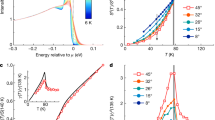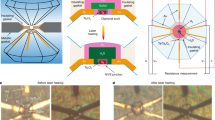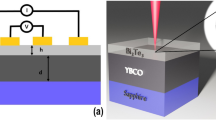Abstract
In conventional superconductors, the superconducting gap in the electronic excitation spectrum prevents scattering of low-energy electrons. In high-temperature superconductors (HTSs), an extra gap, the pseudogap1, develops well above the superconducting transition temperature TC. Here, we present a new avenue of investigating the pseudogap state, using scanning tunnelling microscopy (STM) of resonances generated by single-atom scatterers. Previous studies on the superconducting state of HTSs2 have led to a fairly consistent picture in which potential scatterers, such as Zn, strongly suppress superconductivity in an atomic-scale region, while generating low-energy excitations with a spatial distribution—as imaged by STM3,4—indicative of the d-wave nature of the superconducting gap. Surprisingly, we find that similar native impurity resonances coexist spatially with the superconducting gap at low temperatures and survive virtually unchanged on warming through TC. These findings demonstrate that properties of impurity resonances in HTSs are not determined by the nature of the superconducting state, as previously suggested, but instead provide new insights into the pseudogap state.
This is a preview of subscription content, access via your institution
Access options
Subscribe to this journal
Receive 12 print issues and online access
$259.00 per year
only $21.58 per issue
Buy this article
- Purchase on SpringerLink
- Instant access to full article PDF
Prices may be subject to local taxes which are calculated during checkout




Similar content being viewed by others
Change history
15 January 2009
In the version of this article originally published, Fig. 1c depicted a CuO plane, instead of the intended CuO2 plane. The lattice should have appeared as below. The text of the article and conclusions reached are unaffected. The error has been corrected in the HTML and PDF versions of the article.
References
Timusk, T. & Statt, B. The pseudogap in high-temperature superconductors: an experimental survey. Rep. Prog. Phys. 62, 61–122 (1999).
Balatsky, A. V., Vekhter, I. & Zhu, J.-X. Impurity-induced states in conventional and unconventional superconductors. Rev. Mod. Phys. 78, 373–433 (2006).
Hudson, E. W. et al. Interplay of magnetism and high-Tc superconductivity at individual Ni impurity atoms in Bi2Sr2CaCu2O8+δ . Nature 411, 920–924 (2001).
Pan, S. H. et al. Imaging the effects of individual zinc impurity atoms on superconductivity in Bi2Sr2CaCu2O8+δ . Nature 403, 746–750 (2000).
Maeda, A., Yabe, T., Takebayashi, S., Hase, M. & Uchinokura, K. Substitution of 3d metals for Cu in Bi2(Sr0.6Ca0.4)3Cu2Oy . Phys. Rev. B 41, 4112–4117 (1990).
Kluge, T. et al. Clear distinction between the underdoped and overdoped regime in the Tc suppression of Cu-site-substituted high-Tc cuprates. Phys. Rev. B 52, R727–R730 (1995).
Bobroff, J. et al. Persistence of Li induced Kondo moments in the superconducting state of cuprates. Phys. Rev. Lett. 86, 4116–4119 (2001).
MacFarlane, W. A. et al. Dynamics of the local moment induced by nonmagnetic defects in cuprates. Phys. Rev. Lett. 85, 1108–1111 (2000).
Ouazi, S. et al. Impurity-induced local magnetism and density of states in the superconducting state of YBa2Cu3O7 . Phys. Rev. Lett. 96, 127005 (2006).
Tallon, J. L., Williams, G. V. M., Flower, N. E. & Bernhard, C. Phase separation, pseudogap and impurity scattering in the HTS cuprates. Physica C 282–287, 236–239 (1997).
Williams, G. V. M., Tallon, J. L. & Dupree, R. NMR study of magnetic and nonmagnetic impurities in YBa2Cu4O8 . Phys. Rev. B 61, 4319–4325 (2000).
Nachumi, B. et al. Muon spin relaxation studies of Zn-substitution effects in high-Tc cuprate superconductors. Phys. Rev. Lett. 77, 5421–5424 (1996).
Hudson, E. W., Pan, S. H., Gupta, A. K., Ng, K. W. & Davis, J. C. Atomic-scale quasi-particle scattering resonances in Bi2Sr2CaCu2O8+δ . Science 285, 88–91 (1999).
Hudson, E. W. et al. STM study of novel resonances in Bi2Sr2CaCu2O8+δ . Physica B 329–333, 1365–1366 (2003).
Yazdani, A., Howald, C. M., Lutz, C. P., Kapitulnik, A. & Eigler, D. M. Impurity-induced bound excitations on the surface of Bi2Sr2CaCu2O8 . Phys. Rev. Lett. 83, 176–179 (1999).
Salkola, M. I., Balatsky, A. V. & Scalapino, D. J. Theory of scanning tunneling microscopy probe of impurity states in a d-wave superconductor. Phys. Rev. Lett. 77, 1841–1844 (1996).
Le Tacon, M. et al. Two energy scales and two distinct quasiparticle dynamics in the superconducting state of underdoped cuprates. Nature Phys. 2, 537–543 (2006).
Tanaka, K. et al. Distinct Fermi-momentum-dependent energy gaps in deeply underdoped Bi2212. Science 314, 1910–1913 (2006).
Boyer, M. C. et al. Imaging the two gaps of the high-temperature superconductor Bi2Sr2CuO6+x . Nature Phys. 3, 802–806 (2007).
Kondo, T., Takeuchi, T., Kaminski, A., Tsuda, S. & Shin, S. Evidence for two energy scales in the superconducting state of optimally doped (Bi,Pb)2(Sr,La)2CuO6+δ . Phys. Rev. Lett. 98, 267004 (2007).
Ouazi, S., Bobroff, J., Alloul, H. & MacFarlane, W. A. Correlation length in cuprate superconductors deduced from impurity-induced magnetization. Phys. Rev. B 70, 104515 (2004).
Pimenov, A. V. et al. Nickel impurity-induced enhancement of the pseudogap of cuprate high-Tc superconductors. Phys. Rev. Lett. 94, 227003 (2005).
Dora, B., Maki, K., Virosztek, A. & Vanyolos, A. Pseudogap enhancement due to magnetic impurities in d-density waves. Phys. Rev. B 75, 132504 (2007).
Tallon, J. L. Normal-state pseudogap in Bi2Sr2CaCu2O8 characterized by impurity scattering. Phys. Rev. B 58, R5956–R5959 (1998).
Tallon, J. L., Bernhard, C., Williams, G. V. M. & Loram, J. W. Zn-induced Tc reduction in high-Tc superconductors: Scattering in the presence of a pseudogap. Phys. Rev. Lett. 79, 5294–5297 (1997).
Kruis, H. V., Martin, I. & Balatsky, A. V. Impurity-induced resonant state in a pseudogap state of a high-Tc superconductor. Phys. Rev. B 64, 054501 (2001).
Zhu, J.-X., Kim, W., Ting, C. S. & Carbotte, J. P. Quasiparticle states around a nonmagnetic impurity in a d-density-wave state of high-Tc cuprates. Phys. Rev. Lett. 87, 197001 (2001).
Morr, D. K. Resonant impurity states in the d-density-wave phase. Phys. Rev. Lett. 89, 106401 (2002).
Wang, Q.-H. Mechanism of pseudogap probed by a local impurity. Phys. Rev. Lett. 88, 057002 (2002).
Chakravarty, S., Laughlin, R. B., Morr, D. K. & Nayak, C. Hidden order in the cuprates. Phys. Rev. B 63, 094503 (2001).
Acknowledgements
We thank Y. Wang for his help in the preparation of this manuscript and A. V. Balatsky, J. E. Hoffman, K. M. Lang, P. A. Lee, T. Senthil and X.-G. Wen for their helpful comments. This research was supported in part by a Cottrell Scholarship awarded by the Research Corporation, by the MRSEC program of the NSF under award DMR 02-13282, and also by NSF CAREER award DMR-034891.
Author information
Authors and Affiliations
Contributions
K.C., M.C.B. and W.D.W. shared equal responsibility for all aspects of this project from instrument construction to data collection and analysis. T.K. grew the samples and helped refine the STM. T.T. and H.I. contributed to sample growth. E.W.H. advised.
Corresponding author
Rights and permissions
About this article
Cite this article
Chatterjee, K., Boyer, M., Wise, W. et al. Visualization of the interplay between high-temperature superconductivity, the pseudogap and impurity resonances. Nature Phys 4, 108–111 (2008). https://doi.org/10.1038/nphys835
Received:
Accepted:
Published:
Issue date:
DOI: https://doi.org/10.1038/nphys835
This article is cited by
-
Impurity bound states in fully gapped d-wave superconductors with subdominant order parameters
Scientific Reports (2017)
-
Distribution of the Impurity Resonance Energy in Bi2Sr2CaCu2O8+δ Observed by Scanning Tunneling Spectroscopy
Journal of Superconductivity and Novel Magnetism (2013)
-
Impurity Resonance States in Bi2Sr1.6La0.4CuO6+δ
Journal of Superconductivity and Novel Magnetism (2012)
-
First direct observation of the Van Hove singularity in the tunnelling spectra of cuprates
Nature Communications (2011)
-
Impurity-Related Local Density-of-States Modulation in Bi2Sr2Ca(Cu1−x Zn x )2O8+δ Probed by Scanning Tunneling Spectroscopy
Journal of Superconductivity and Novel Magnetism (2011)



